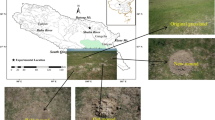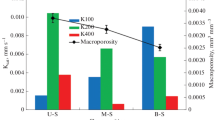Abstract
Purpose
The relationship between soil macropore and plant roots warrants special attention because it influences the behavior of water in soil. However, the influence of shrub roots on soil macropores in shrub-encroached grasslands is poorly understood. The objectives of this study were to quantify soil macropores and root architecture in a shrub-encroached grassland in northern China, and to reveal the relationship between shrub roots and soil macropore.
Materials and methods
In this study, treatments were performed that corresponded to three successional states of the shrub C. microphylla L. with three different shrub densities. At each site, three undisturbed soil cores were excavated under the shrub canopies, and a Philips medical scanner was used to simultaneously visualize and quantify the soil and root architectures.
Results and discussion
Strong positive correlations between root volume, length, and surface area and the solid surface/solid volume ratio were found, and greater root growth was noted in more porous soil. The results highlighted that the soil macropore characteristics corresponded well with the root characteristics of the soils for the three treatments. Soil macroporosity and macropore volume increased with increasing shrub root network density. In addition, the influence of plant roots on soil macropores increased with increasing shrub encroachment. The study confirmed that the large number of macropores found in the soils under shrubs was attributed to the great degree of root development there.
Conclusions
The greater degree of macroporosity under shrubs was attributed to the larger root network density, which might cause greater amounts of water to be concentrated in the deep soil layer by macropore flow under shrub patches. The influence of plant roots on soil macropores increased with increasing shrub encroachment.








Similar content being viewed by others
References
Arsenault JL, Poulcur S, Messier C, Guay R (1995) WinRHlZO™, a root measuring system with a unique overlap correction method. HortScience 30:906
Blouin M, Barot S, Roumet C (2007) A quick method to determine root biomass distribution in diameter classes. Plant Soil 290:371–381
Capowiez Y, Pierret A, Moran CJ (2003) Characterisation of the three-dimensional structure of earthworm burrow systems using image analysis and mathematical morphology. Biol Fertil Soils 38:301–310
Carminati A, Vetterlein D, Weller U, Vogel HJ, Oswald SE (2009) When roots lose contact. Vadose Zone J 8:805–809
Clothier BE, Green SR (1997) Roots: the big movers of water and chemical in soil. Soil Sci 162(8):534–543
Dunkerley D (2000) Hydrologic effects of dryland shrubs: defining the spatial extent of modified soil water uptake rates at an Australian desert site. J Arid Environ 45:159–172
Feeney DS, Crawford JW, Daniell T, Hallett PD, Numan N, Ritz K, Rivers M, Young IM (2006) Three-dimensional microorganization of the soil–root–microbe system. Microb Ecol 52(1):151–158
FEI (2016) Amira & Avizo 3D software. [WWW Document]. URL. https://www.fei.com/software/amira-avizo/. Accessed date: 1 March 2017
Gallardo A, Schlesinger WH (1992) Carbon and nitrogen limitations of soil microbial biomass in desert ecosystems. Biogeochemistry 18:1–17
Grevers MCJ, Jong ED, St Arnaud RJ (1989) The characterization of soil macroporosity with CT scanning. Can J Soil Sci 69(3):629–637
Gunde AC, Bera B, Mitra SK (2010) Investigation of water and CO2 (carbon dioxide) flooding using micro-CT (micro-computed tomography) images of Berea sandstone core using finite element simulations. Energy 35:5209–5216
Heijs AWJ, de Lange J, Schoute JFT, Bouma J (1995) Computed tomography as a tool for non-destructive analysis of flow patterns in macroporous clay soils. Geoderma 64:183–196
Helliwell JR, Sturrock CJ, Grayling KM, Tracy SR, Flavel RJ, Young IM, Whalley WR, Mooney SJ (2013) Applications of X-ray computed tomography for examining biophysical interactions and structural development in soil systems: a review. Eur J Soil Sci 64:279–297
Hu X, Li ZC, Li XY, Liu Y (2015) Influence of shrub encroachment on CT-measured soil macropore characteristics in the Inner Mongolia grassland of northern China. Soil Tillage Res 150:1–9
Hu X, Li ZC, Li XY, Wang P, Zhao YD, Liu LY, Lv YL (2018a) Soil macropore structure under different land uses characterized by x-ray computed tomography in the Qinghai Lake watershed, NE Qinghai-Tibet plateau. Pedosphere 28(3):478–487
Hu X, Lyu YL, Liu Y, Li XY, Li ZC, Sun ZT, Cheng YQ, Guo LL, Liu LY (2018b) Exclosure on CT-measured soil macropore characteristics in the Inner Mongolia grassland of northern China. J Soils Sediments 18:718–726
Hu X, Li X Y, Wang P, Liu Y, Wu X C, Li Z C, Zhao Y D, Cheng Y Q, Guo L L, Lyu Y L, Liu L Y (2019) Influence of exclosure on CT-measured soil macropores and root architecture in a shrub-encroached grassland in northern China. Soil & Tillage Research 187:21–30
Illerhaus B, Onel Y, Goebbels A (2004) Correction techniques for 2D detectors to be used with high energy X-ray sources for CT, part II. In: Developments in X-ray tomography proceedings of the society of photo-optical instrumentation engineers (SPIE) 5535:329–334
Jarvis NJ (2007) A review of non-equilibrium water flow and solute transport in soil macropores: principles, controlling factors and consequences for water quality. Eur J Soil Sci 58(3):523–546
Johnson MS, Lehmann J (2006) Double-funneling of trees: Stemflow and root-induced preferential flow. Ecoscience 13(3):324–333
Katuwal S, Norgaard T, Moldrup P, Lamandé M, Wildenschild D, de Jonge LW (2015) Linking air and water transport in intact soils to macropore characteristics inferred from X-ray computed tomography. Geoderma 237–238:9–20
Kuka K, Illerhaus B, Fox CA, Joschko M (2013) X-ray computed microtomography for the study of the soil-root relationship in grassland soils. Vadose Zone J 12. https://doi.org/10.2136/vzj2013.01.0014
Larsbo M, Koestel J, Jarvis N (2014) Relations between macropore network characteristics and the degree of preferential solute transport. Hydrol Earth Syst Sci 18:5255–5269
Li XY, Yang ZP, Li YT, Lin H (2009) Connecting ecohydrology and hydropedology in desert shrubs: Stemflow as a source of preferential flow in soils. Hydrol Earth Syst Sci 13:2023–2030
Li XY, Hu X, Zhang ZH, Peng HY, Zhang SY, Li GY, Li L, Ma YJ (2013) Shrub hydropedology: preferential water availability to deep soil layer. Vadose Zone J 12(4):1539–1663
Luo L, Lin H, Li S (2010a) Quantification of 3D soil macropore networks in different soil types and land uses using computed tomography. J Hydrol 393:53–64
Luo L, Lin H, Schmidt J (2010b) Quantitative relationships between soil macropore characteristics and preferential flow and transport. Soil Sci Soc Am J 74:1929–1937
Meijering EHW, Niessen WJ, Pluim JPW, Viergever MA (1999) Quantitative comparison of sinc-approximating kernels for medical image interpolation. In: Medical Image Computing and Computer-Assisted Intervention, MICCAI’99, Proceedings, vol. 1679:210–217
Mooney SJ, Morris C (2008) Morphological approach to understanding preferential flow using image analysis with dye tracers and X-ray computed tomography. Catena 73(2):204–211
Mooney SJ, Pridmore TP, Helliwell J, Bennett MJ (2012) Developing X-ray computed tomography to non-invasively image 3-D root systems architecture in soil. Plant Soil 352:1–22
Munkholm LJ, Heck RJ, Deen B (2012) Soil pore characteristics assessed from X-ray micro- CT derived images and correlations to soil friability. Geoderma 181–182:22–29
Naveed M, Moldrup P, Emmanuel A, Wildenschild D, Edene M, Lamandé M, Vogel HJ, de Jonge LW (2013) Revealing soil structure and functional macroporosity along a clay gradient using x-ray computed tomography. Soil Sci Soc Am J 77:403–411
Peng HY (2012) Spatial pattern of shrub patches and its ecohydrological mechanism at the typical steppe in Inner Mongolia. Unpublished PhD thesis. Beijing Normal University, China, pp 47–48
Peng HY, Li XY, Li GY, Zhang H, Zhang S Y, Li L, Zhao GQ, Jiang ZY, Ma YJ (2013) Shrub encroachment with increasing anthropogenic disturbance in the semiarid Inner Mongolian grasslands of China. Catena 109: 39–48
Pierret A, Capowiez Y, Moran CJ, Kretzschmar A (1999) X-ray computed tomography to quantify tree rooting spatial distributions. Geoderma 90:307–326
Pierret A, Doussan C, Capowiez Y, Bastardie F, Pages L (2007) Root functional architecture: a framework for modeling the interplay between roots and soil. Vadose Zone J 6:269–281
Sammartino S, Michel E, Capowiez Y (2012) A novel method to visualize and characterize preferential flow in undisturbed soil cores by using multi-slice helical CT. Vadose Zone J 11(1):vzj2011.0100
Schmidt S, Bengough AG, Gregory PJ, Grinev DV, Otten W (2012) Estimating root–soil contact from 3D X-ray microtomographs. Eur J Soil Sci 63:776–786
Soil Survey Staff (1987) Keys to soil taxonomy, 3rd edn. Cornell University, Ithaca
Stewart JB, Moran CJ, Wood JT (1999) Macropore sheat: quantification of plant root and soil macropore association. Plant Soil 211:59–67
Taina IA, Heck RJ, Elliot TR (2008) Application of X-ray computed tomography to soil science: a literature review. Can J Soil Sci 88(1):1–20
Tracy SR, Roberts JA, Black CR, McNeill A, Davidson R, Mooney SJ (2010) The X-factor: visualizing undisturbed root architecture in soils using X-ray computed tomography. J Exp Bot 61:311–313
Tracy SR, Black CR, Roberts JA, Sturrock C, Mairhofer S, Craigon J, Mooney SJ (2012) Quantifying the impact of soil compaction on root system architecture in tomato (Solanum lycopersicum L.) by X-ray micro-computed tomography (CT). Ann Bot 110:511–519
Van Schaik NLMB (2009) Spatial variability of infiltration patterns related to site characteristics in a semi-arid watershed. Catena 78:36–47
Vogel MN, Goeppert B, Maksimovic O, Brodoefel H, Faul C, Claussen CD, Horger M (2010) CT features of neutropenic enterocolitis in adult patients with hematological diseases undergoing chemotherapy. Fortschr Röntgenstr 182(12):1076–1081
Walkley A, Black IA (1934) An examination of the Degtjareff method for determining soil organic matter and a proposed modification of the chromic acid titration method. Soil Sci 37(1):29–38
Weiler M, Naef F (2003) An experimental tracer study of the role of macropores in infiltration in grassland soils. Hydrol Process 17(2):477–493
Wu GL, Liu Y, Yang Z, Cui Z, Deng L, Chang XF, Shi ZH (2017) Root channels to indicate the increase in soil matrix water infiltration capacity of arid reclaimed mine soils. J Hydrol 546:133–139
Yanai RD, Eissenstat DM (2002) Coping with herbivores and pathogens: a model of optimal root turnover. Funct Ecol 16(6):865–869
Young IM (1998) Biophysical interactions at the root-soil interface: a review. J Agric Sci 130:1–7
Zobel RW, Baligar VC, Kinraide TB (2007) Fine root diameters can change in response to changes in nutrient concentrations. Plant Soil 297:243–254
Funding
This study was financially supported by National Key R&D Program of China (Grant number: 2016YFA0601901), the National Science Foundation of China (Grant number: 41471018), the PCSIRT (IRT-15R06), the National Key Research and Development Program of China (2016YFE0203400-01), and projects supported by the State Key Laboratory of Earth Surface Processes and Resource Ecology.
Author information
Authors and Affiliations
Corresponding author
Additional information
Responsible editor: Lu Zhang
Publisher’s note
Springer Nature remains neutral with regard to jurisdictional claims in published maps and institutional affiliations.
Rights and permissions
About this article
Cite this article
Hu, X., Li, XY., Guo, LL. et al. Influence of shrub roots on soil macropores using X-ray computed tomography in a shrub-encroached grassland in Northern China. J Soils Sediments 19, 1970–1980 (2019). https://doi.org/10.1007/s11368-018-2218-6
Received:
Accepted:
Published:
Issue Date:
DOI: https://doi.org/10.1007/s11368-018-2218-6




